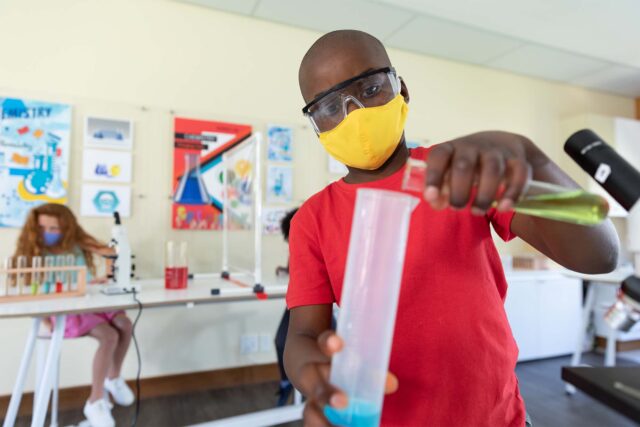The California State Board of Education (SBE) adopted the California Next Generation Science Standards (NGSS) to transform science teaching and learning in K-12 schools in 2013. The new standards emphasize “three-dimensional learning”: disciplinary core ideas, crosscutting concepts, and science and engineering practices. Further, they are aligned with the Common Core State Standards to prepare students for college and careers. In this report, we leverage a survey conducted at the end of the 2016-17 school year to examine districts’ implementation of the new standards. We find:
- Implementation is uneven. Most of the survey respondents are either very familiar (60%) or somewhat familiar (31%) with the NGSS. However, a quarter of respondents in low-performance districts-defined as those in the bottom quartile of student participation in the Advanced Placement exams-are only slightly familiar with the new standards. Seventy-eight percent of districts report that they are implementing the new standards, and the percentage of urban districts reporting this is substantially higher (94%).
- About half of districts have adopted the SBE’s preferred models. For middle schools, about half of districts opted for the preferred middle school model and close to half have chosen the three-course model (with earth and space science interwoven into each course) for high schools. About 20 percent of districts had not made a decision at the time of the survey, which is a concern given the state’s implementation timeline. Rural districts were less likely to have made a decision about middle school courses, while urban districts were less likely to have made a decision for high school.
- Instructional materials, science labs and equipment, teacher shortage, and teacher training present big challenges. The state is scheduled to adopt textbooks and other instructional materials in 2018; at the time of the survey (spring 2017), 59 percent of districts reported instructional materials as a big challenge. Most also have issues with the quantity of science labs, the adequacy of science labs, and the quantity of science equipment in their districts. About a quarter of districts reported not having sufficient credentialed science teachers, and more than 70 percent of districts face challenges in teacher training.
- Successful implementation may require changes in other elements of the K-12 system. The state’s minimum high school graduation requirements include only two years of instruction in life sciences and physical sciences, while NGSS require a minimum of three years of instruction. Local districts can require additional years, but most (60%) do not. In addition, science education has taken a back seat to math and English and very few students have access to a quality science education in early grades.
The Next Generation Science Standards are an important step toward improving science education; however, the state needs to take additional steps to help districts implement NGSS and prioritize science education. We recommend several actions, including updating statewide high school graduation requirements, incorporating specific science metrics into the state accountability system, and leveraging NGSS to improve science education in the early grades.
Topics
K–12 EducationLearn More

California Needs More Math and Science Teachers

Commentary: California Must Prioritize Science Education to Stay Competitive

Prioritizing Computer Science in California Schools

The Impact of COVID-19 on Science Education


